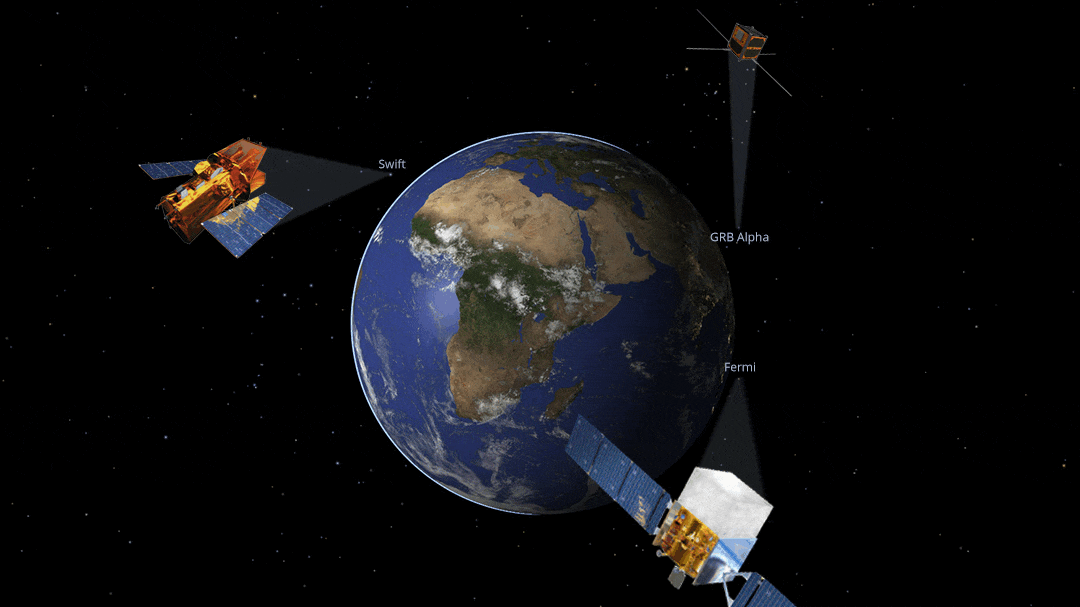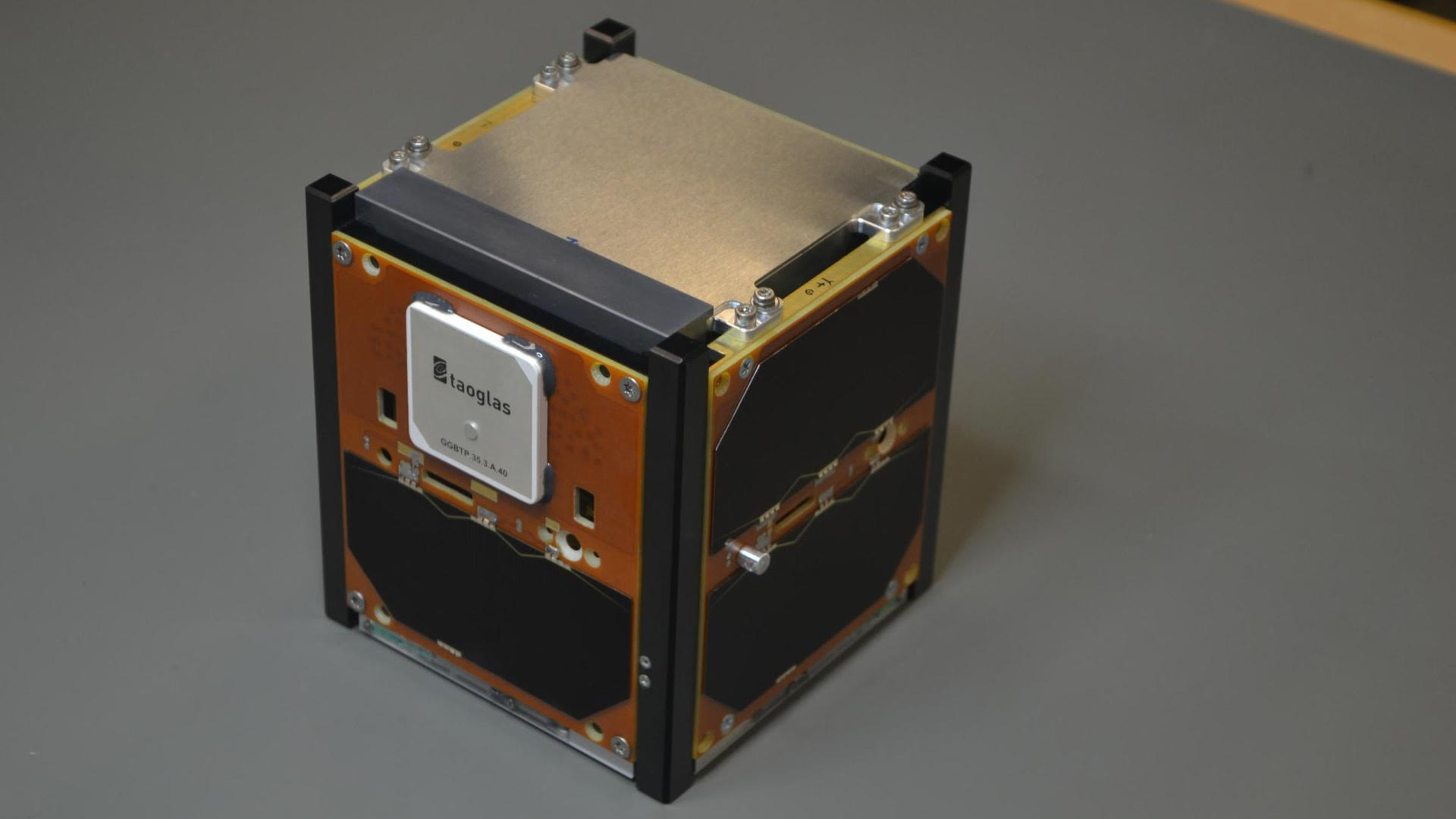A tiny Eastern European cubesat measured a monster gamma-ray burst better than NASA. Here's how
The brightest ever gamma-ray burst dazzled detectors on flagship satellites. This tiny cubesat rose to the occasion.

The brightest gamma-ray burst in 10,000 years that swept over Earth last year blinded all of NASA's flagship gamma-ray missions. A tiny Eastern European cubesat, however, rose to the occasion, taking an accurate measurement of the monster burst's peak intensity.
When Czech astronomer Jakub Řípa received a call from a colleague at NASA on Oct. 9, 2022 inquiring about data from his team's tiny cubesat GRBAlpha, he was skeptical of the request. NASA's satellites had just detected what appeared like the brightest gamma-ray burst ever seen, which was so bright that it completely dazzled the NASA spacecraft's detectors. Řípa's colleague wanted to know whether GRBAlpha had been luckier, as the NASA data didn't allow scientists to calculate the historical event's peak intensity.
Gamma-ray bursts are the most powerful explosions known to happen in the universe that arise when giant stars collapse into black holes at the end of their lives. Within mere seconds or minutes, these bursts unleash an amount of energy greater than the output of our sun over its entire life-time. The shorter gamma-ray bursts are usually produced in collisions of super-dense stellar remnants known as neutron stars. Until recently, there were only a handful of space missions capable of detecting gamma-ray bursts, all of them costly and complex machines built by the world's leading space agencies.
Řípa didn't think that GRBAlpha, an experimental cubesat built on a tiny budget by a team of Hungarian, Slovak and Czech astronomers, could have done any better than those missions. The satellite, launched in March 2021, had, in fact, only recently been enabled to gather data 24/7.
"Our satellite was traversing the radiation belts around the north pole at the time of the burst," Řípa told Space.com in an email. "When I looked at the data, at first I did not realize that the big bump in the light curve was the gamma-ray burst."
Since it reached orbit two years ago, GRBAlpha has detected over 27 gamma-ray bursts, Řípa's colleague Norbert Werner, an astrophysics professor at the Masaryk University in Brno, the Czech Republic, told Space.com in an interview. These gamma-ray bursts generated on average 400 photons per second on GRBAlpha's innovative detector. The "bump in the light curve" at which Řípa was staring in October counted 22,000 photons per second.
Get the Space.com Newsletter
Breaking space news, the latest updates on rocket launches, skywatching events and more!
"Given how strong this feature was in the data, I thought it was part of the radiation belt," Řípa said. "When I realized it was a gamma-ray burst, I was shocked, I did not expect to see anything this bright."
Gamma-ray bursts are not rare. Everyday, one flashes at our planet from somewhere in the universe. Many more are believed to light up the cosmos without us being able to detect them. Astronomers believe that these bursts are produced when a black hole just being born from a collapsing giant star gets overwhelmed by the material falling into it and ejects it in the form of powerful jets. The jets are narrow, like a beam of a flashlight, and have to be pointed directly at Earth to be detected by our satellites.

The gamma-ray burst of Oct.9, officially named GRB 221009A, was so bright because the energy of the jet was focused into a very narrow angle, a recent analysis revealed. Having since gained the nickname BOAT, for the "brightest of all time," GRB 221009A may have been the brightest gamma-ray burst to have hit Earth in 10,000 years.
Werner thinks that BOAT didn't dazzle GRBAlpha because the detector on the 1U cubesat (a cube 4 by 4 by 4 inches, or 10 by 10 by 10 centimeters in size) is by design much smaller than those on NASA's flagship gamma-ray burst spotters Fermi and Swift, or the European Space Agency's (ESA) Integral.
"The detectors on the main gamma-ray burst detecting satellites were overwhelmed by [GRB 221009A's] enormous brightness," said Werner. "Our data is unsaturated, meaning that we were able to measure the peak brightness of this extraordinary burst and provide information that the main gamma-ray burst observing spacecraft couldn't."
An instrument for measuring solar X-rays on ESA's Solar Orbiter mission also got the peak brightness, as did a Chinese experimental satellite SATech-01 and Russia's Spektr-RG.
For Werner, however, the GRBAlpha result is a huge victory. The astronomer dreamed up the satellite in 2016 together with his Hungarian colleague András Pál of Hungary's Konkoly Observatory, which provided funding for the mission. The first gamma-ray burst-detecting cubesat ever launched, GRBAlpha has paved the way for a more ambitious international endeavor that plans to develop an entire constellation of gamma-ray burst detecting cubesats. Such a constellation, Werner says, would be able to make up for the shortcomings of the current fleet of large monolithic missions.
Although GRBAlpha demonstrated its strength with BOAT, the original motivation for the cubesat constellation came from the limited ability of the current fleet to locate sources of these explosions. The only spacecraft in orbit capable of immediately identifying where these bursts come from is NASA's Swift. This spacecraft, however, sees only about one ninth of the sky at any given time, which means it misses a large fraction of the gamma-ray bursts that reach Earth.
"It misses 8 out of 9 gamma-ray bursts," said Werner. "We don't have a mission that would cover the full sky and also provide localization."
It was a lucky coincidence that SWIFT was looking in the right direction at the time when the BOAT lit up the sky. And it was also a lucky coincidence that GRBAlpha was in the right place to see it. The cubesat constellation envisioned by Werner and his colleagues would see the whole sky at all times and would enable astronomers to calculate the locations of the gamma-ray burst sources from the tiny differences in the times of their arrivals at the different satellites. The method, known as triangulation, is commonly used with GPS satellites for navigation on Earth.
A paper detailing GRBAlpha's measurements of GRB 221009A was published in the journal Astronomy and Astrophysics on March 28. The team's paper detailing the mission's operations has also recently been accepted for publication in the same journal.
Follow Tereza Pultarova on Twitter @TerezaPultarova. Follow us on Twitter @Spacedotcom and on Facebook.
Join our Space Forums to keep talking space on the latest missions, night sky and more! And if you have a news tip, correction or comment, let us know at: community@space.com.

Tereza is a London-based science and technology journalist, aspiring fiction writer and amateur gymnast. Originally from Prague, the Czech Republic, she spent the first seven years of her career working as a reporter, script-writer and presenter for various TV programmes of the Czech Public Service Television. She later took a career break to pursue further education and added a Master's in Science from the International Space University, France, to her Bachelor's in Journalism and Master's in Cultural Anthropology from Prague's Charles University. She worked as a reporter at the Engineering and Technology magazine, freelanced for a range of publications including Live Science, Space.com, Professional Engineering, Via Satellite and Space News and served as a maternity cover science editor at the European Space Agency.
-
DMaxwell I'm curious about the cost difference between the GRBAlpha satellite, which successfully recorded the gamma burst, & the NASA satellites that didn't.Reply
If an array of these tiny satellites could be launched for less than the cost of one of the larger satellites, or even just within the ballpark of the price of one, it would be an easier sell to the budget decision makers.
If so, it would increase the chances of getting funding for such an array, whether from official government sources, universities, or even from one of those rare space-minded, philanthropic private investors.
I really, really hope they do build an array of these little cube sats. Because positional blind luck isn't going to get us the needed comprehensive data, & unfortunately it seems that the larger satellites aren't up to the task at present.









